Related Research Articles
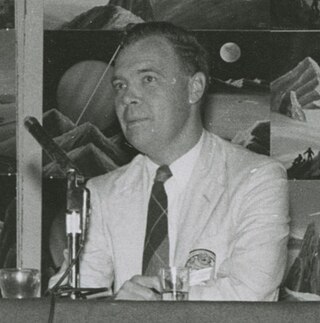
Harry Clement Stubbs, better known by the pen name Hal Clement, was an American science fiction writer and a leader of the hard science fiction subgenre. He also painted astronomically oriented artworks under the name George Richard.
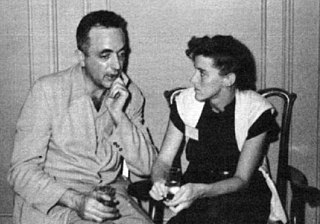
Katherine Anne MacLean was an American science fiction author best known for her short fiction of the 1950s which examined the impact of technological advances on individuals and society.

Murray Leinster was a pen name of William Fitzgerald Jenkins, an American writer of genre fiction, particularly of science fiction. He wrote and published more than 1,500 short stories and articles, 14 movie scripts, and hundreds of radio scripts and television plays.
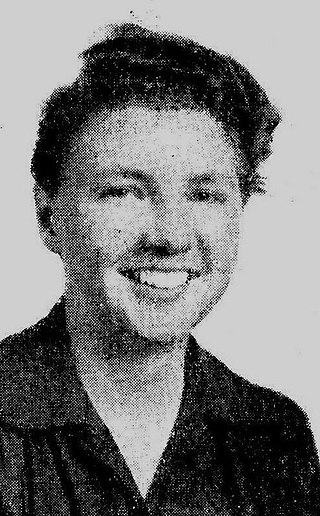
Leigh Douglass Brackett was an American science fiction writer known as "the Queen of Space Opera." She wrote the screenplays for The Big Sleep (1946), Rio Bravo (1959), and The Long Goodbye (1973). She worked on an early draft of The Empire Strikes Back (1980), elements of which remained in the film; she died before it went into production. In 1956, her book The Long Tomorrow made her the first woman ever shortlisted for the Hugo Award for Best Novel, and, along with C. L. Moore, one of the first two women ever nominated for a Hugo Award.

A science fiction magazine is a publication that offers primarily science fiction, either in a hard-copy periodical format or on the Internet. Science fiction magazines traditionally featured speculative fiction in short story, novelette, novella or novel form, a format that continues into the present day. Many also contain editorials, book reviews or articles, and some also include stories in the fantasy and horror genres.

The Ship Who Sang (1969) is a science fiction novel by American writer Anne McCaffrey, a fix-up of five stories published 1961 to 1969. It is also the title of the 1961 novelette which is the first of these stories. The series started by the book, the "Brain & Brawn Ship series", is sometimes called the "Ship Who Sang series".
"The Little Black Bag" is a science fiction novelette by American writer Cyril M. Kornbluth, first published in the July 1950 edition of Astounding Science Fiction. It won the 2001 Retroactive Hugo Award for Best Novelette and was also recognized as the 13th best all-time short science fiction story in October and November 1971 Analog Science Fact & Fiction poll, The Reference Library review article, tied with "Microcosmic God" by Theodore Sturgeon. It was among the stories selected in 1970 by the Science Fiction Writers of America as one of the best science fiction short stories published before the creation of the Nebula Awards. As such, it was published in The Science Fiction Hall of Fame Volume One, 1929–1964.
"Microcosmic God" is a science fiction novelette by American writer Theodore Sturgeon. Originally published in April 1941 in the magazine Astounding Science Fiction, it was recognized as one of the best science fiction short stories published before the Nebula Awards by the Science Fiction Writers of America in 1970, and was named as one of the best science fiction stories in polls by Analog Science Fiction and Fact in 1971 and Locus in 1999. In 1976, it was also published as a comic book version in issue 3 of Starstream: Adventures in Science Fiction, a comic anthology in four issues by Gold Key Comics.
"Permafrost" is a science fiction novelette by American writer Roger Zelazny, published in 1986.
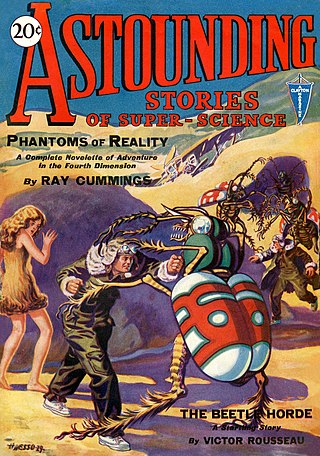
Analog Science Fiction and Fact is an American science fiction magazine published under various titles since 1930. Originally titled Astounding Stories of Super-Science, the first issue was dated January 1930, published by William Clayton, and edited by Harry Bates. Clayton went bankrupt in 1933 and the magazine was sold to Street & Smith. The new editor was F. Orlin Tremaine, who soon made Astounding the leading magazine in the nascent pulp science fiction field, publishing well-regarded stories such as Jack Williamson's Legion of Space and John W. Campbell's "Twilight". At the end of 1937, Campbell took over editorial duties under Tremaine's supervision, and the following year Tremaine was let go, giving Campbell more independence. Over the next few years Campbell published many stories that became classics in the field, including Isaac Asimov's Foundation series, A. E. van Vogt's Slan, and several novels and stories by Robert A. Heinlein. The period beginning with Campbell's editorship is often referred to as the Golden Age of Science Fiction.
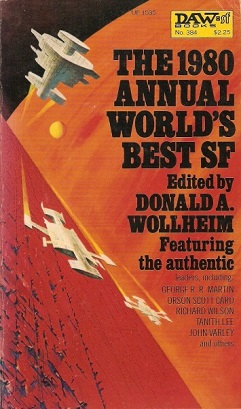
The 1980 Annual World's Best SF is an anthology of science fiction short stories edited by Donald A. Wollheim and Arthur W. Saha, the ninth volume in a series of nineteen. It was first published in paperback by DAW Books in May 1980, followed by a hardcover edition issued in September of the same year by the same publisher as a selection of the Science Fiction Book Club. For the hardcover edition the original cover art of Jack Gaughan was replaced by a new cover painting by Gary Viskupik. The paperback edition was later reissued by DAW under the variant title Wollheim's World's Best SF: Series Nine.

The 1981 Annual World's Best SF is an anthology of science fiction short stories edited by Donald A. Wollheim and Arthur W. Saha, the tenth volume in a series of nineteen. It was first published in paperback by DAW Books in May 1981, followed by a hardcover edition issued in August of the same year by the same publisher as a selection of the Science Fiction Book Club. For the hardcover edition the original cover art of Michael Mariano was replaced by a new cover painting by John Gampert.

The 1983 Annual World's Best SF is an anthology of science fiction short stories edited by Donald A. Wollheim and Arthur W. Saha, the twelfth volume in a series of nineteen. It was first published in paperback by DAW Books in May 1983, followed by a hardcover edition issued in September of the same year by the same publisher as a selection of the Science Fiction Book Club. For the hardcover edition the original cover art was replaced by a new cover painting by Richard Powers.

World's Best Science Fiction: 1967 is an anthology of science fiction short stories edited by Donald A. Wollheim and Terry Carr, the third volume in a series of seven. It was first published in paperback by Ace Books in 1967. It was reprinted by the same publisher in 1970 under the alternate title World's Best Science Fiction: Third Series.

World's Best Science Fiction: 1969 is an anthology of science fiction short stories edited by Donald A. Wollheim and Terry Carr, the fifth volume in a series of seven. It was first published in paperback by Ace Books in 1969, followed by a hardcover edition issued in September of the same year by the same publisher as a selection of the Science Fiction Book Club.
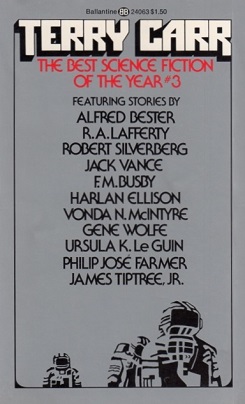
The Best Science Fiction of the Year #3 is an anthology of science fiction short stories edited by Terry Carr, the third volume in a series of sixteen. It was first published in paperback by Ballantine Books in July 1974, and reissued in July 1976.
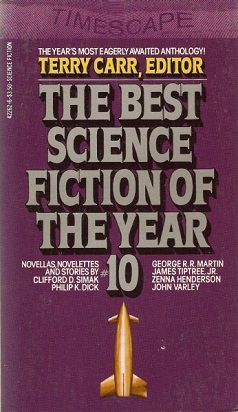
The Best Science Fiction of the Year #10 is an anthology of science fiction short stories edited by Terry Carr, the tenth volume in a series of sixteen. It was first published in paperback by Pocket Books in July 1981, and in trade paperback and hardcover and trade paperback by Gollancz in the same year.

The Best Science Fiction of the Year #11 is an anthology of science fiction short stories edited by Terry Carr, the eleventh volume in a series of sixteen. It was first published in paperback by Pocket Books in July 1982, and in hardcover by Gollancz in the same year.
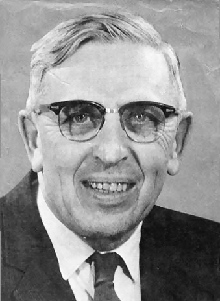
Clifford Donald Simak was an American science fiction writer. He won three Hugo Awards and one Nebula Award. The Science Fiction Writers of America made him its third SFWA Grand Master, and the Horror Writers Association made him one of three inaugural winners of the Bram Stoker Award for Lifetime Achievement. He is associated with the pastoral science fiction subgenre.

Marie Lilian Vibbert is an American science fiction author.
References
- ↑ Kettle, Roy (August 2010). "Found! The Lost Kafoozalum" (PDF). Sense of Wonder Stories (4): 12–22.
- 1 2 3 4 5 6 7 8 9 Davin, Eric Leif (2006). Partners in Wonder: Women and the Birth of Science Fiction 1926–1965 . Lexington Books. ISBN 0-7391-1266-X.
- ↑ "1959 Hugo Awards". The Hugo Awards. World Science Fiction Society. 26 July 2007. Retrieved 28 July 2011.
- ↑ "1961 Hugo Awards". The Hugo Awards. World Science Fiction Society. 26 July 2007. Retrieved 28 July 2011.
- ↑ "Bibliography: The Wings of a Bat". The Internet Speculative Fiction Database. Retrieved 29 July 2011.
- ↑ Michael Ashley (2000). The History of the science fiction magazine. Liverpool University Press. p. 134. ISBN 978-0-85323-855-3 . Retrieved 29 July 2011.